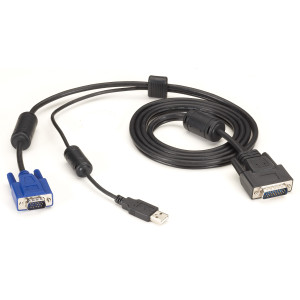Your shopping cart is empty!
MENU
The SW2006A-USB-EAL Secure KVM Switch with USB, EAL4+ Certified/TEMPEST Level I (Level A) Qualified, VGA, surpasses the security profiles of most other KVM switches. In addition to its superior hardware-based data-isolation features, the switch has been certified for Common Criteria Evaluation Assurance to Level 4+ (EAL4+), augmented by ALC_FLR.2 and ATE_DPT.2.
The Common Criteria is an international standardized process for information technology security evaluation, validation, and certification. The Common Criteria scheme is supported by the National Security Agency through the National Information Assurance Program (NIAP). EAL4+ itself defines a common set of tests to evaluate the security of an IT product relating to its supply chain, from design and engineering to manufacturing and distribution.
The ServSwitch Secure KVM Switch with USB, EAL4+ Certified/TEMPEST Level I (Level A) Qualified, VGA provides control and separation of two PC CPUs/servers connected to secure and non-secure networks through just one keyboard, monitor, and mouse. Users can safely switch among the connected computers operating at different classification levels without worry. Plus, it is TEMPEST USA NSTISSAM Level I and NATO SDIP-27 Level A qualified. What this means is the low radiated emissions profile of the switch meets the appropriate requirements for conducted/radiated electromagnetic emissions. The TEMPEST designation is required by military organizations. As a security standard, it pertains to technical security countermeasures, standards, and instrumentation that prevent or minimize the exploitation of vulnerable data communications equipment by technical surveillance or eavesdropping.
Threat: Microprocessor malfunction or unanticipated software bugs cause data to flow between ports.
Solution: Unidirectional keyboard and mouse data flow is enforced by hardware "data diodes" so data isolation doesn't rely on software integrity.
Threat: Malicious modification of microprocessor software causing data to leak between ports.
Solution: Microprocessors are one-time programmable and soldered on the board. Data isolation does not rely on software; it is ensured by hardware.
Threat: Subversive snooping by detecting electromagnetic radiation emitted from the equipment.
Solution: Carefully shielded metal case with dual shielding in critical areas and a low emissions profile.
Threat: Detection of signals on one computer by monitoring for crosstalk (leakage) signals on another computer.
Solution: No connections to sensitive analog inputs (such as computer microphone ports). Minimum crosstalk separation of 60 dB provided between signals from one computer and input or I/O signals to another.
Threat: Timing analysis attacks (looking at what happens on one port to determine data flow patterns on another).
Solution: Only one computer is connected at a time to any shared circuitry. Links are unidirectional, preventing timing analysis.
Threat: Signaling by shorting the power supply or loading the power.
Solution: Each port is independently powered by its USB port. Shorting the power supply on one port will not cause the power on the other ports to be switched off. The shared keyboard, mouse, and monitor circuitry are powered by the power supply. The lack of a common power supply minimizes electronic signaling.
Threat: Data transfer by using common storage or common RAM.
Solution: Shared circuitry and the keyboard and mouse are powered down at each switchover to clear all volatile memory of any previous connections.
Threat: Physical proximity between ports enables data leakage.
Solution: Isolation is improved by placing the red and black ports at the opposite edges of the switch.
Threat: Accidental port switching
Solution: Locked-down operation disables all keyboard hotkey and mouse switching functions in both software and hardware so that data corruption can't inadvertently cause an unanticipated channel change. The only way to change the channels is with the front-panel keys. There is only one button per channel, so channel selection is clear. Color-coded visual feedback confirms the channel selection.
This Black Box product is subject to the International Traffic in Arms Regulations (ITAR). The ITAR (22 CFR parts 120-130) governs the manufacture, export, and temporary import of defense articles, the furnishing of defense services, and brokering activities involving items described on the USML (U.S. Munitions List).
| Technology | |
| Transmission Distance | Cable length: 6 ft. (1.8 m) or 12 ft. (3.6 m) |
| Video | |
| Resolution | Digital: 165 MHz per DVI link, dual-link DVI supported; Analog: 1920 x 1280 |
| Power | |
| Rated Power | Input: 100-240 VAC, 50-60 Hz, external, 0.5 amps (maximum) Output: 5 VDC, 2.5 amps (maximum), 12.5 watts |
| Ratings | |
| RoHS Compliant | Yes |
| Download Name | File Size |
| SW2006A-USB-EAL Data Sheet.pdf | 442.28KB |
| Image | Model | Product Name | Price | |
 |
EHNSECURE2 | Black Box EHNSECURE2 Secure KVM Switch Cable, VGA and USB to HD26 | $64.19 |